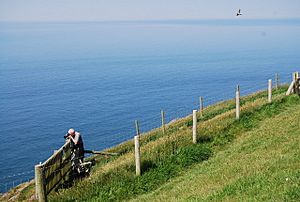St Bees Head RSPB reserve facts for kids
Quick facts for kids St Bees Head RSPB Reserve |
|
|---|---|

Guillemots on the North Head
|
|
| Location | Cumbria, England |
| Elevation | 90 m (300 ft) |
| Operator | Royal Society for the Protection of Birds |
| Website | St Bees Head |
The St Bees Head RSPB Reserve is a special place in Cumbria, England. It's a coastal area looked after by the RSPB. This reserve is home to thousands of amazing seabirds!
You can spot many different kinds of birds here. Some of them include kittiwakes, fulmars, guillemots, and razorbills. You might also see cormorants, puffins, shags, and herring gulls. St Bees Head is super important because it's the only place in England where black guillemots come to breed.
Another special bird, the rock pipit, also breeds here. This bird loves rocky coasts. St Bees Head is one of only two places in Cumbria where it is known to breed.
Meet the Birds of St Bees Head
Besides the many seabirds, other cool birds live and breed at St Bees Head. These include the wise tawny owl and the speedy sparrowhawk. You might also spot a powerful peregrine or a clever raven.
The RSPB works with other groups like Natural England and the National Trust. They are all working together to make the coastal areas even better for wildlife. One big goal is to create the right kind of grassy areas. This would help the beautiful chough birds return to the area.
Visiting St Bees Head Reserve
If you visit, you can use the observation stations on the North Head footpath. These are great spots to watch the birds safely. The cliffs here are very tall, reaching about 90 metres high. It's important to be careful and stay away from the edge when you are exploring.
Protecting This Special Place
St Bees Head is a very important natural area, so it has several special protections:
- It is a Heritage Coast. This means it's a beautiful coastal area that is protected for its natural beauty and wildlife.
- It is also a Site of Special Scientific Interest (SSSI). This protection is for its amazing plants, animals, and geology.
The land part of St Bees Head is protected, but the sea around it is also important. The sea off St Bees Head is part of the Cumbria Coast Marine Conservation Zone. This zone helps protect the ocean environment. It was first set up in 2013 and then made even bigger in 2019. This was done to better protect the areas where seabirds find their food.
Local groups, like the NWIFCA (North Western Inshore Fisheries and Conservation Authority), are working with Natural England and the RSPB. They are asking people to voluntarily avoid using fishing nets near St Bees Headland. This helps keep the birds safe while they are looking for food.


